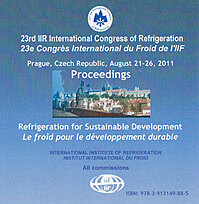
Document IIF
Pompes à chaleur dans les applications de nettoyage industriel.
Heat pumps in industrial cleaning applications.
Numéro : pap. ID: 881
Auteurs : PAASKE B., REINHOLDT L., HEERUO C.
Résumé
The overall objective of the project is to promote the use of heat pumps in energy-intensive industrial washing applications. Actual measurements carried out at a production facility on washing plants for metal items show that heat pumps have an energy savings potential of app. 40-50%. The washing plants typically have an annual energy consumption of 80 MWh, and the contribution to the overall energy consumption of the production facilities is considerable. Throughout the project, a heat pump solution will be developed and commissioned for a specific washing application at a production facility in Denmark. To promote the use in similar applications, the total potential at the production facility is mapped and a software tool will be developed. The software tool will provide energy consultants, manufacturers and end-users with a quick assessment of possible heat pump solutions in different washing applications. The project was initiated by a medium-sized company and funded by the Danish Energy Association. The medium-sized company develops and commissions industrial washing applications. Mapping has shown that heat pumps can minimize the total power consumption by 50%, enabling large reductions of consumed energy and short payback periods.
Documents disponibles
Format PDF
Pages : 9 p.
Disponible
Prix public
20 €
Prix membre*
Gratuit
* meilleur tarif applicable selon le type d'adhésion (voir le détail des avantages des adhésions individuelles et collectives)
Détails
- Titre original : Heat pumps in industrial cleaning applications.
- Identifiant de la fiche : 30001740
- Langues : Anglais
- Source : Proceedings of the 23rd IIR International Congress of Refrigeration: Prague, Czech Republic, August 21-26, 2011. Overarching theme: Refrigeration for Sustainable Development.
- Date d'édition : 21/08/2011
Liens
Voir d'autres communications du même compte rendu (569)
Voir le compte rendu de la conférence
-
Energy saving. 90°C hot water NH3 heat pumps in...
- Auteurs : BOONE J.
- Date : 12/06/2015
- Langues : Anglais
- Source : Le ultime tecnologie del freddo e del condizionamento. Atti del 16° Convegno Europeo: June 12-13, 2015, Milano, Italia.
- Formats : PDF
Voir la fiche
-
Development of a compact CO2 heat pump for indu...
- Auteurs : HASHIMOTO K., SAIKAWA M., MISUMI S., et al.
- Date : 25/06/2012
- Langues : Anglais
- Source : 10th IIR-Gustav Lorentzen Conference on Natural Working Fluids (GL2012). Proceedings. Delft, The Netherlands, June 25-27, 2012.
- Formats : PDF
Voir la fiche
-
Categorization of industrial heat pump for inte...
- Auteurs : ICHIKAWA A., JEONG J., MIYAOKA Y., YAMAGUCHI S., SAITO K.
- Date : 31/08/2021
- Langues : Anglais
- Source : 13th IEA Heat Pump Conference 2021: Heat Pumps – Mission for the Green World. Conference proceedings [full papers]
- Formats : PDF
Voir la fiche
-
Heat pump COP, part 1: generalized method for s...
- Auteurs : REINHOLDT L., KRISTOFERSSON J., ZÜHLSDORF B., et al.
- Date : 18/06/2018
- Langues : Anglais
- Source : 13th IIR Gustav Lorentzen Conference on Natural Refrigerants (GL2018). Proceedings. Valencia, Spain, June 18-20th 2018.
- Formats : PDF
Voir la fiche
-
Sensible and latent heat recovery system for dr...
- Auteurs : HIGASHI T., KAIDA T., ZHANG L.
- Date : 21/08/2023
- Langues : Anglais
- Source : Proceedings of the 26th IIR International Congress of Refrigeration: Paris , France, August 21-25, 2023.
- Formats : PDF
Voir la fiche
